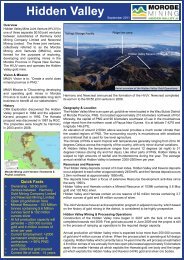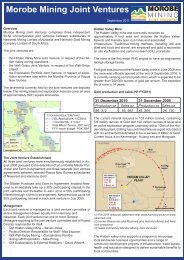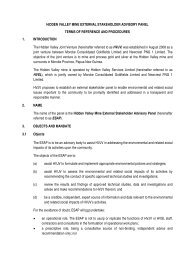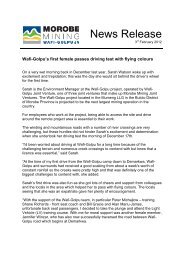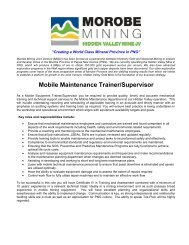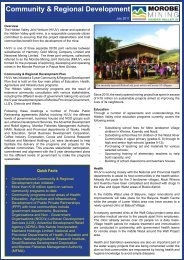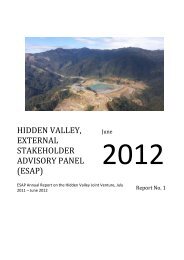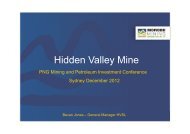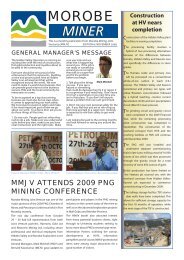ppt255 hidden valley general safety induction(2).pdf
ppt255 hidden valley general safety induction(2).pdf
ppt255 hidden valley general safety induction(2).pdf
Create successful ePaper yourself
Turn your PDF publications into a flip-book with our unique Google optimized e-Paper software.
HIDDEN VALLEY SAFETY<br />
INDUCTION
Welcome to the Hidden<br />
Valley Gold Project General<br />
Safety Induction<br />
SLIDE TITLE
Safety Induction<br />
OUR VISION<br />
Hidden Valley Gold Projects Vision is to provide<br />
a<br />
“Healthy and Safe environment for all<br />
employees, contractors and visitors at all<br />
project sites”<br />
“No Injuries”
Safety Induction<br />
GLOBALLY …3000 PEOPLE DIE AT WORK<br />
EVERY DAY!
Safety Induction<br />
But the real losers in any accident are the who?<br />
• Killed<br />
• Crippled<br />
• Injured<br />
• Their families<br />
No amount of money can compensate for the pain of<br />
personal injury or disability to ourselves or someone<br />
close to us.
Safety Induction<br />
Heading<br />
WHO IS<br />
RESPONSIBLE?<br />
FIRE<br />
CAMP<br />
FIRE<br />
GIRLS<br />
THAT’S<br />
RUFF!
Safety Induction<br />
There is little to absolutely no point in attributing<br />
individual responsibility or blame for accidents<br />
after the accident has happened.<br />
What we need to be clear<br />
about is…<br />
… who within a workplace has a<br />
responsibility to avoid accidents and<br />
injuries, either to themselves or their<br />
workmates?
Safety Induction<br />
FROM<br />
MANAGEMENT:<br />
Providing Safety Equipment<br />
Implementing Systems and Procedures<br />
Ensuring Training<br />
TO<br />
EVERYBODY:<br />
Using Proper Equipment<br />
Following Procedures<br />
Providing Feedback
Safety Induction<br />
We believe that the people who really know the<br />
problems to do with <strong>safety</strong> and professionalism<br />
within any industry are the professionals who<br />
work within it.<br />
YOU!
Safety Induction<br />
Remember<br />
We want your ideas and support<br />
on how to make it a safer, more<br />
professional and better place to<br />
work.
Safety Induction<br />
In short, everyone can and needs to participate in<br />
ensuring a safe working environment by<br />
understanding and supporting each other.<br />
And that’s one reason<br />
why we are here today –<br />
to understand how we can help each other
Safety Induction<br />
PURPOSE<br />
To provide you with:<br />
– Sufficient information for you to work safely on<br />
how to work safely on the project site.<br />
– Explain the behaviors expected of you while<br />
working on the Hidden Valley Gold Project
Safety Induction<br />
The Hidden Valley “5” Golden Rules<br />
Purpose<br />
• Have in place a few clear rules which if<br />
breached could lead to a serious injury or<br />
fatality
Safety Induction<br />
Rule 1<br />
• I will not operate any mobile plant or light<br />
vehicle unless I have been assessed and<br />
authorised in writing by the Construction<br />
Manager or their delegate
Safety Induction<br />
Rule 2<br />
• Prior to working on any equipment, it must be<br />
isolated and de-energized;
Safety Induction
Safety Induction<br />
Rule 3<br />
• Never position yourself:<br />
– under a suspended load;
Safety Induction
Safety Induction<br />
Rule 4<br />
• All work at height above 2.0 meters must use<br />
fall protection/fall restraint/arrest equipment;
Safety Induction<br />
Death of a young<br />
man that could<br />
have easily been<br />
prevented
Safety Induction<br />
Rule 5<br />
• Never enter a Confined Space or specified<br />
Restricted Area unless authorised to do so.
Safety Induction<br />
What if I cant perform a task without<br />
breaching a Golden Rule?<br />
The work is to cease and the matter<br />
brought to the attention of the<br />
Construction Manager or their<br />
delegate for determination
Safety Induction<br />
Emergency Response<br />
What is an EMERGENCY ????<br />
• Fire<br />
• Personal injuries<br />
• Personnel trapped<br />
• Transport incidents
Emergency Action Plan<br />
Radio Call<br />
Channel 1<br />
Emergency/Emergency/Emergency<br />
•State Your Name<br />
•State Your Location<br />
•State the type of Emergency<br />
•State the Assistance Required<br />
Safety Induction<br />
DO NOT HANG UP UNTIL THE PERSON HAS CONFIRMED ALL<br />
THE INFORMATION
Safety Induction<br />
SOMETIMES THINGS DO GO<br />
“Wrong”
Safety Induction
Safety Induction<br />
SOMETIMES PEOPLE<br />
DON’T GET INJURED
Safety Induction
OPERATOR ESCAPED<br />
WITHOUT INJURY<br />
Safety Induction
Safety Induction<br />
AND SOMETIMES THEY DO…..
Safety Induction
Safety Induction<br />
….and 1 serious injury or<br />
fatality.<br />
….10 minor injuries….<br />
….there are 30 cases<br />
of damage to plant or<br />
equipment….<br />
For every 600<br />
near misses<br />
or hazardous<br />
situations….<br />
Act before it’s too late:<br />
Report ALL near misses, minor injuries and hazardous<br />
situations
Safety Induction<br />
CONSTRUCTION INDUSTRY<br />
• How many people will die on construction<br />
sites in Australia this year?<br />
30 – 40<br />
• # 1 - Transport and Storage Industry<br />
• # 2 - Agriculture Industry<br />
• # 3 - Construction Industry
CONSTRUCTION INDUSTRY<br />
Safety Induction
Safety Induction<br />
DO YOU…….<br />
REPORT HAZARDS AND NEAR MISSES<br />
USE THE RIGHT EQUIPMENT FOR THE JOB<br />
HAVE THE SKILLS NEEDED<br />
PLAN AND EVALUATE<br />
ASK QUESTIONS<br />
Its up to you !
Safety Induction<br />
Hazard Awareness<br />
Hazard - a source of<br />
Potentially damaging energy or something that<br />
injure you<br />
Risk - the most reasonable<br />
Likely chance of being injured
Safety Induction
Not following rules<br />
Safety Induction<br />
Identification Of Hazards<br />
Chemicals<br />
Uneven surfaces<br />
Struck by<br />
Attitude<br />
Oil on floor<br />
Heavy objects<br />
Electricity<br />
Sharp objects<br />
Lack of knowledge<br />
Working at<br />
Heights<br />
Lack of training<br />
Noise
Safety Induction
Safety Induction<br />
The Hierarchy of Hazard/Risk Controls<br />
• Elimination<br />
MOST RELIABLE<br />
• Substitution<br />
• Engineering controls<br />
• Administrative controls<br />
• Personal protective<br />
Equipment (PPE)<br />
LEAST RELIABLE
Safety Induction<br />
3 Step Process of Hazard Identification<br />
Step1<br />
Identify the<br />
hazard<br />
Step 2<br />
Assess the<br />
risk<br />
Re- evaluate<br />
Step 3<br />
Control the<br />
risk
Hazard Management Tools<br />
Safety Induction<br />
• Site Rules and Procedures<br />
• Workplace Inspections<br />
• Job Safety Analysis<br />
• Behavior / Safety Observations<br />
• Incident Investigations<br />
• Risk Assessments
Safety Induction<br />
SAFETY SIGNS<br />
SAFETY SIGNS<br />
Safety signs are provided to help<br />
protect your health and <strong>safety</strong> so<br />
Always obey <strong>safety</strong> signs<br />
Never remove any <strong>safety</strong> sign unless<br />
you have permission from<br />
management<br />
Never deface or alter a sign<br />
Never obstruct visibility by stacking<br />
materials equipment in front of<br />
signs<br />
Keep signs clean and legible
Safety Induction<br />
SAFETY SIGNS<br />
REGULATION<br />
The message on the sign<br />
must always be obeyed.<br />
CAUTION<br />
Take proper precautions<br />
for the identified<br />
hazard.<br />
EMERGENCY<br />
INFORMATION<br />
Indicates the type and<br />
location of emergency and<br />
fire fighting equipment.
Safety Induction<br />
SAFETY SIGNS<br />
MANDATORY PPE
SAFETY SIGNS<br />
Safety Induction<br />
These actions are NEVER ALLOWED in the areas with these signs.<br />
1 2 3<br />
NO DIGGING<br />
NO OPEN FLAME<br />
NO ADMITTANCE
The instruction on the sign MUST ALWAYS<br />
be obeyed.<br />
Safety Induction
Safety Induction<br />
The symbol tells you the hazard that<br />
you must beware of.<br />
1 2 3<br />
4 5 6
Safety Induction<br />
SAFETY SIGNS<br />
Symbolic emergency equipment<br />
signs with supporting text<br />
First Aid<br />
General indication<br />
of direction to<br />
emergency equipment
Safety Induction<br />
SAFETY SIGNS<br />
Fire Hose Reel<br />
Fire Hydrant Hose<br />
Fire Extinguisher
The Fire Triangle<br />
Safety Induction
Safety Induction<br />
Fire Extinguishers<br />
• Water<br />
• Foam<br />
• Dry Chemical Powders<br />
• Inert Gases<br />
• Vapourising Liquids<br />
• Wet Chemicals
Fires Ain’t Fires<br />
Safety Induction
Fire Extinguisher Anatomy<br />
Safety Induction
Safety Induction<br />
Dry chemical powder extinguishers<br />
These have a red cylinder with a white<br />
horizontal band.<br />
Dry Chemical Powder extinguishes the fire by<br />
breaking the chain reaction between the fuel<br />
vapours and the oxygen.<br />
It also smothers the fuel.<br />
It is not a good coolant.<br />
It is electrically non-conductive.
IF YOU COME ACROSS A FIRE:<br />
Initiate the Emergency Procedure<br />
Tell others to get clear<br />
Ensuring you do not endanger yourself<br />
Fight fire with available equipment<br />
Evacuate if necessary<br />
Report to nearest Muster Point<br />
Never re-enter a burning building<br />
Safety Induction<br />
FIRE PROCEDURE AND EVACUATION
Safety Induction<br />
Extinguishing the fire<br />
• Pull the pin<br />
• Test the extinguisher<br />
• Aim the nozzle at the base of the fire.<br />
• Sweep side to side at the base of the<br />
fire.
Safety Induction<br />
What is a Restricted Area?<br />
Barricades and restricted areas<br />
• A barricade is any temporary or semipermanent<br />
structure or fence erected to protect<br />
or to deny access to unauthorised persons to a<br />
restricted area because of the presence of<br />
hazards.
Safety Induction<br />
USE OF RED AND WHITE TAPE<br />
DANGER<br />
This tape is used to barricade areas where a high risk hazard exists and where there<br />
is a definite risk of injury or harm if precautions are not taken.
Safety Induction<br />
USE OF BLACK AND YELLOW TAPE<br />
CAUTION - RISK OF DANGER<br />
This tape should be used to warn people of a potential hazard.<br />
•
BARRICADING AND SIGNS<br />
Safety Induction<br />
Set up barriers or barricades around the edges of the excavation.<br />
Place warning signs to warn people of the excavation.<br />
Divert traffic away from the excavation area<br />
Install flashing amber lights for night-time warning.
Safety Induction<br />
USING BARRICADING<br />
• Ensure the barricading perimeter extends far enough out to prevent<br />
contact with the hazard.<br />
• Position the barricading at a height so it is clearly visible.<br />
• Tie off barricading tape to posts so it is kept in position.<br />
• Posts should either be driven into the ground or fitted with a heavy base.<br />
• Position <strong>safety</strong> signs around the barricade perimeter.<br />
• Position flashing warning lights around barricaded areas, such as<br />
excavations, during hours of darkness.
Safety Induction<br />
Workplace Hazards<br />
• The Hidden Valley Gold Project has<br />
identified a number of workplace hazards<br />
associated with our scope of work. We will<br />
discuss these and our expectations now!<br />
• High Impact Low Frequency Hazards<br />
• General Workplace Hazards
Safety Induction<br />
High Impact Hazards<br />
• Working at Heights<br />
• Confined Spaces<br />
• Vehicles and Plant<br />
• Electrical Equipment<br />
• Hot Work<br />
• Excavations<br />
• Machine Guarding<br />
• Isolation
Safety Induction<br />
Working at Heights<br />
When working above 2.0m we are required to<br />
control the hazards<br />
There are 2 main levels of control<br />
•Erecting a physical barrier.<br />
(Scaffolds, Hoardings, Mesh screens)<br />
•Providing personnel fall protection.<br />
(Fall arrest and fall resistance)<br />
Always ensure that drop zones are established below<br />
when person are working above. (Barricades and<br />
signage)
Safety Induction<br />
Working at heights<br />
• All personnel working at heights must have been trained in<br />
the application and use of Fall Arrest/Restraint equipment.<br />
• All Fall Arrest/Restraint equipment must be inspected by a<br />
competent person every six months and immediately prior<br />
to use.<br />
• All Fall Arrest/Restraint equipment must be listed on a<br />
register and maintained.
Safety Induction<br />
Excavations<br />
You must not work in excavations deeper<br />
than 1.5 metres which have not been<br />
battered, benched or shored.<br />
Bench (1.2 m cutback)<br />
battered<br />
face<br />
Battering involves digging the excavation<br />
face so it is sloped rather than vertical.<br />
Benching is used for excavations which<br />
are deeper than three (3) metres.<br />
Shoring should be used when benching<br />
and battering are impractical.
Safety Induction<br />
Preventing collapses<br />
Things you can do to prevent<br />
the excavation from collapsing<br />
include:<br />
• store excavated rock and<br />
soil at least 500mm from the<br />
edges;<br />
• keep vehicles and heavy<br />
machinery away from the<br />
edges;<br />
• pump ground water out of the<br />
excavation; and<br />
• use ditches or windrows to<br />
divert surface water away<br />
from the excavation.
Safety Induction<br />
Types of confined spaces<br />
A confined space is any fully<br />
or partly enclosed space<br />
which:<br />
• is not a normal place of work;<br />
• has a restricted means of<br />
entry and exit; and<br />
• may have a dangerous<br />
atmosphere.<br />
This includes:<br />
•<br />
storage tanks;<br />
• boilers and pressure vessels;<br />
• silos;<br />
• pits;<br />
• pipes;<br />
• sewers;<br />
• shafts;<br />
• ducts; and<br />
• noise.
Safety Induction<br />
CONFINED SPACE<br />
Nobody is allowed to enter a confined space without<br />
first being issued with a confined space permit<br />
Persons entering the confined space must have been<br />
trained to do so.
Safety Induction<br />
LADDERS<br />
All ladders and step ladders are to be of industrial rating<br />
•Capable of supporting swl 120 kg<br />
•Ladders are to be listed on a register and inspected on a<br />
regular basis and prior to use<br />
•Wooden ladders are not be painted they can be clear varnished<br />
•Extension ladders mechanisms are to be operating to<br />
manufacturers standards<br />
•Ladders are not work platforms
Safety Induction<br />
LADDERS<br />
When using a ladder you should:<br />
Always face towards the ladder<br />
while climbing up or down it<br />
The ladder must be inspected and<br />
safe to use<br />
Keep a three point of contact at all<br />
times<br />
The ladder must be tied off or<br />
steadied by another person<br />
The ladder should be positioned at<br />
1 in 4 angle
Safety Induction<br />
Checking Metal Ladders<br />
Sharp edges and burrs<br />
Twisted or deformed<br />
ladder parts<br />
Metal fatigue<br />
and cracks<br />
Loose or missing<br />
screws and rivets<br />
Corrosion due to<br />
contact with acids<br />
or caustic soda
Safety Induction<br />
Securing compressed gas cylinders<br />
Always store cylinders:<br />
FULL<br />
EMPTY<br />
• in racks;<br />
• in the upright position;<br />
• secured with steel chains or<br />
clamps; and<br />
• with the cylinder valve fully closed.<br />
Always store cylinders with the cylinder<br />
valve fully closed.<br />
Because empty cylinders still contain a<br />
small amount of gas the cylinder<br />
valve must still be closed.<br />
Never secure cylinders with rope.<br />
Store full and empty cylinders separately<br />
according to gas type.
Safety Induction<br />
Safety signs for gas cylinder storage areas<br />
Cylinder storage areas must be signposted with Danger warning signs such as:<br />
Cylinder storage areas must be signposted with signs to identify each<br />
type of gas stored in the area, such as:<br />
NON- FLAMMABLE<br />
NON-TOXIC<br />
GAS<br />
Acetylene and LPG Nitrogen Oxygen
Safety Induction
Safety Induction<br />
Compressed air hose faults<br />
Before you use a compressed air hose you should make sure:<br />
• the hose couplings are securely clamped;<br />
• the hose itself does not have any holes,<br />
cuts, burns or bubbling in the ply<br />
wrapping;<br />
• the hose couplings do not turn around<br />
inside the hose when you twist them; and<br />
• the hose couplings are each fitted with a<br />
rubber grommet.
Safety Induction<br />
Disconnecting air tools<br />
Close off the compressed<br />
air valve<br />
Press the trigger to bleed<br />
off the air<br />
Remove the <strong>safety</strong> clips<br />
Disconnect the hose<br />
couplings
Safety Induction<br />
Transport Rules - Light Vehicles<br />
Inside the security gate the following will apply:<br />
• Speed Limit 40 KPH or as posted<br />
• Seat belts to be worn at all time<br />
• Rotating Amber warning light<br />
• Reverse warning alarm<br />
• 2.5 kg - 4.5 kg Dry Chemical Powder Extinguisher<br />
• Emergency First Aid Kit<br />
• No passengers unless seat belt available and on<br />
approved seating. (ie.NOT in the back of the “ute”)<br />
• All light vehicles give way to Heavy Vehicles (Self<br />
Preservation !)
Safety Induction
Safety Induction
Safety Induction
Safety Induction<br />
GENERAL ELECTRICAL SAFETY<br />
The risk of electric shock from correctly installed and<br />
maintained Electrical Equipment is negligible, provided<br />
that sensible precautions are taken by the employees and<br />
correct safe work procedures are followed.<br />
We need to be aware of the electrical hazards and<br />
take the appropriate precautions
Safety Induction<br />
Checking portable electrical equipment<br />
Always check for:<br />
•cracks in the insulation casing;<br />
•loose or missing casing screws;<br />
•splits or damage to the power cord<br />
insulation;<br />
•exposed wires;<br />
•loose connection between the power<br />
cord and the tool;<br />
•bent or missing plug pins; and<br />
•cracks in the plug.
Safety Induction<br />
Double insulated power tools<br />
Non-conductive, shatter proof<br />
outer casing<br />
Double Insulated<br />
symbol<br />
Double insulation protects the user from electrical shock if interior wiring<br />
contacts the outer casing, but it does not provide total protection from<br />
electric shock because:<br />
• immersion of the tool in water can allow an earth leakage; and<br />
• double insulation does not protect against any defects in the cord, plug or<br />
power outlet.
Safety Induction<br />
Electrical inspection tags<br />
Each portable electrical tool should be fitted with a current inspection tag.<br />
Owner<br />
COMPLETE WHERE APPLICABLE<br />
Test Date<br />
Equipment type<br />
Licence Number<br />
Plant Number<br />
Signature<br />
PLEASE INFORM YOUR ELECTRICAL SERVICES IF THIS APPLIANCE IS DEFECTIVE IN ANY WAY<br />
RED:<br />
GREEN:<br />
BLUE:<br />
YELLOW:<br />
January to March<br />
April to June<br />
July to September<br />
October to December
Safety Induction<br />
Residual current devices<br />
If a fault causes electricity to flow to earth,<br />
the Residual Current Device will disconnect<br />
the electricity supply, avoiding the risk of a<br />
fatal shock.<br />
They disconnect the electricity supply at a<br />
level of 30 milliAmps.<br />
It will disconnect within 10 -15 milliseconds.<br />
RCD<br />
Power<br />
Outlet<br />
If you are unsure if you have earth leakage protection,<br />
use a portable Residual Current Device.
You should never:<br />
• kink the power cord;<br />
• allow power cords to contact water, oil or<br />
steam;<br />
• leave power tools switched on when not being used;<br />
• handle electrical equipment with wet hands, in high humidity, or<br />
outdoors after a rain storm; or<br />
• disconnect a power tool without first switching off at the power<br />
outlet.<br />
Safety Induction<br />
Sheet 7 - Using Portable Electrical Equipment<br />
Position power cords so they will not become a trip hazard for other people.<br />
Fully unwind extension cords from storage reels before energising them.
Safety Induction<br />
ELECTRIC SHOCK<br />
ALL cases of electric shock are serious.<br />
ALL have the potential to result in a fatality
Safety Induction<br />
Scaffold <strong>safety</strong><br />
Keep walkways free of obstacles, tools and<br />
equipment.<br />
Keep platforms free of grease and mud.<br />
Climb from one level to another using the ladders<br />
provided.<br />
Use a crane, hoist or winch to carry materials up to<br />
and down from the scaffold.<br />
You should never:<br />
• exceed the safe working load of the scaffold;<br />
• stand on the hand-rails; or<br />
• work from a defective scaffold.
ISOLATION<br />
Safety Induction
Isolation<br />
Safety Induction
Isolation<br />
Safety Induction
Safety Induction<br />
Out of Service Tags<br />
• All plant and equipment that is not “Fit for<br />
Purpose must be tagged “Out of Service”.<br />
• Any person can apply an “Out of Service”<br />
tag<br />
• The “Out of Service” tag can only be<br />
removed by an authorised repair person/ or<br />
Supervisor.
Out of Service<br />
Safety Induction
Personal Danger Tag<br />
Safety Induction
Hot Work<br />
Safety Induction
Safety Induction<br />
So what is Hot Work?<br />
• Welding,<br />
• Thermal or oxy-acetylene cutting,<br />
• Oxy-acetylene heating,<br />
• Grinding and other fire or spark-producing<br />
operations.<br />
2 principle risks:<br />
• Fires or Explosion, and<br />
• Toxic fumes and gases.
Safety Induction<br />
Setting up for hot work<br />
• Oxy–Acetylene<br />
• Electric Arc Welding<br />
• Grinding<br />
• Special Situations<br />
Confined Spaces<br />
Fuel / Oil Tanks & Systems
Safety Induction<br />
Setting up for hot work<br />
Generally:<br />
• Ventilation<br />
• Fire Equipment<br />
• Lighting<br />
• Demarcation and Guarding<br />
• Housekeeping<br />
• Fire blankets<br />
• Fire watch
Safety Induction<br />
Oxy–Acetylene<br />
• Meets AS 4289: (Oxygen and acetylene gas<br />
reticulation systems.)<br />
• Inspect equipment<br />
• Grease free<br />
• Flash back arrestors<br />
• Secure cylinders<br />
• Pressurising hoses – Go slow<br />
• No cigarette lighters matches etc.
Safety Induction<br />
Electric Arc Welding<br />
• Meets AS 1674.2: (Safety in welding and<br />
allied processes – Electrical)<br />
• Welding machines in good condition<br />
and frame is earthed<br />
• Inspect equipment<br />
• Keep cables as short as possible<br />
• Work cable shorter than electrode<br />
cable<br />
• Securely connect the work lead
Safety Induction<br />
Grinding and Gas Cutting<br />
Do not use a grinder or gas cutting:<br />
• Where there is combustible or flammable<br />
fluids or atmospheres (gases, vapours, or<br />
dusts).<br />
• On drums, barrels, tanks, or other used<br />
containers.<br />
(Unless the item has been properly purged and<br />
“proved safe”)
Machine Guarding<br />
Safety Induction
Safety Induction<br />
So what can happen?<br />
Injury from:<br />
• Pinch points<br />
• Shear points<br />
• Wrap points<br />
• Crush points<br />
• Pull in points<br />
• Thrown objects
Safety Induction<br />
Basic Features<br />
•Physically prevent a person reaching into the<br />
danger zone<br />
•Prevent clothes or hair or other body parts<br />
from becoming caught<br />
•Prevent a hazard from the failure of a<br />
component<br />
•Prevent contact with hot or hazardous fluids<br />
(fluid couplings or torque converters)
Safety Induction<br />
Lifting Plant and<br />
Accessories
Safety Induction<br />
Purpose & Scope<br />
To ensure we reduce to an acceptable level the risk of<br />
personal injury, equipment and environmental<br />
damage that may result from using lifting plant and<br />
accessories.<br />
This Standard applies to the use of ALL lifting<br />
plant & accessories used by Hidden Valley Gold<br />
Project employee’s and contractors.
Safety Induction<br />
So what is Lifting Plant?<br />
• Forklifts<br />
• Franna cranes<br />
• Mobile slewing cranes to 120 tonne<br />
• Vehicle loading crane (Hiab)<br />
• Overhead cranes
Safety Induction<br />
And what are “Accessories”?<br />
• Man cages (Work Box)<br />
• Chains, shackles, blocks, hooks, slings<br />
• Lifting beams<br />
• Equalising beams<br />
• Note: Elevated Work Platforms (EWP’s) and<br />
Scissor Lifts are not to be used as cranes.
Safety Induction<br />
Planning a lift!<br />
• Lift data:<br />
• Equipment data:<br />
• Rigging data:<br />
• Lift computation:<br />
• Proximity to power lines and process areas:<br />
• Local hazards and their controls:<br />
• (Lift plans are carried out by the Crane<br />
Operators and rigging crew)
Safety Induction<br />
Significant Lifts<br />
• Significant lifts include all multiple crane<br />
lifts; lifts over operating facilities where this<br />
may endanger personnel; lifts over power<br />
lines; lifts involving personnel cages; and<br />
lifts at maximum rated loads.
Safety Induction<br />
Marking lifting plant / accessories<br />
• The safe weight it can lift ( SWL)<br />
• The date of manufacture<br />
• Serial or identification number (SN)<br />
• Register is kept of all lifting plant and<br />
accessories
Safety Induction<br />
Storing lifting plant & accessories<br />
• Off the ground;<br />
• Under cover; ( not exposed to sunlight or rain)<br />
• Accessible when required.<br />
• All heavy chain stored in proper storage bins<br />
(accessible to the crane)
Safety Induction<br />
Man cages (Work Boxes)<br />
• Only used when all other forms of access have<br />
been eliminated via a risk analysis.<br />
• People must only be lifted using man cages.<br />
• Each man cage will include integral lifting<br />
gear. No other lifting gear may be used for<br />
lifting man cages.<br />
• Man cages comply with AS1418.17 Design and<br />
Construction of workboxes
Safety Induction<br />
Inspection & Maintenance<br />
• All lifting plant and accessories must be on a<br />
maintenance schedule.<br />
• Approved testing body - test all lifting plant<br />
regularly.<br />
• All serviceable plant tagged<br />
• Test results entered into register of lifting plant<br />
and accessories by the owner of the equipment<br />
tested.<br />
• Any crane brought to site must have current<br />
test certificate and a pre-use <strong>safety</strong> inspection
Safety Induction<br />
Personal Protective Equipment<br />
(PPE)
Safety Induction<br />
Personal Protective Equipment<br />
• Why we use Personal Protective Equipment<br />
(PPE)<br />
• When & Where we use PPE<br />
• What PPE do we use<br />
• Who does What in relation to PPE<br />
(Accountabilities)
Safety Induction<br />
Purpose & Scope<br />
To ensure we reduce the risk of personal injury to an<br />
acceptable level by providing:<br />
• Appropriate PPE for all employee’s contractors and<br />
visitors<br />
• Training for people in how to use the PPE<br />
• Ensuring that project contractors equip their employees<br />
with the appropriate PPE<br />
• This Standard applies to ALL people performing work at<br />
any Hidden Valley Gold Project work site.
Safety Induction<br />
How will I know what’s required?<br />
• Hidden Valley Project Rules<br />
• PNG Legislation<br />
• Signs<br />
• Management Directive<br />
• Risk Assessment<br />
• JSA / SWP
Safety Induction<br />
TYPES OF PPE USED<br />
PPE is provided to protect employees from workplace hazards.<br />
Gloves<br />
Hearing<br />
protection<br />
Helmets<br />
Harnesses<br />
Respiratory<br />
protection<br />
Eye<br />
protection<br />
Use the right PPE for the job you are doing.<br />
NEVER USE DAMAGED PPE!!
Safety Induction
Safety Induction<br />
On site - any operational area<br />
Minimum Personal Protective Equipment:<br />
• Steel capped fully enclosed <strong>safety</strong> footwear;<br />
• Safety glasses with side protection;<br />
• Hard Hat<br />
• High visibility (or reflective) industrial work<br />
clothing meeting used during daylight hours;<br />
• Hearing protection in all areas demarcated as a<br />
noise zone.
Safety Induction<br />
Areas exempt from minimum PPE<br />
• Administration areas unless performing tasks<br />
requiring the use of PPE;<br />
• Washrooms / Showers;<br />
• First aid rooms;<br />
• Enclosed Vehicles;<br />
• Other areas or activities formally designated<br />
as exempt from the use of PPE by the relevant<br />
Project Manager.
Safety Induction<br />
Gloves<br />
• Any situation considered necessary by<br />
person doing the work or by line manager;<br />
based on a risk assessment.
Safety Induction<br />
MANUAL HANDLING<br />
•Always lift correctly – keep your back straight and bend your<br />
knees<br />
•Correct body and hand position – Keep the load close to your<br />
body<br />
•Warm up and stretch before lifting<br />
•Use team lifting techniques<br />
•Use mechanical aids<br />
•Always ask for help if you are unsure of the maximum load<br />
weight<br />
REMEMBER, Manual Lifting is the last resort
Safety Induction<br />
TIPS FOR SAFE LIFTING<br />
Size up the load<br />
Bend your knees<br />
Take small steps<br />
Take a firm grip<br />
Plan your lift from A to B<br />
If the load is too heavy get help<br />
Keep your back straight<br />
Take a balanced position
Safety Induction<br />
Fitness for Work<br />
• Every employee, contractor or visitor has<br />
an obligation to present to any Hidden<br />
Valley worksite in a fit state.<br />
• This means unaffected by drugs, alcohol or<br />
fatigue.<br />
• Zero Tolerance – you cannot enter the site<br />
affected by drugs or alcohol.
Safety Induction<br />
Fitness for work<br />
• No chewing of Beetle Nut on any Hidden<br />
Valley work site or accommodation area.<br />
• No person will be permitted to enter any<br />
Hidden Valley worksite affected by drugs or<br />
alcohol.<br />
• Random testing will be conducted on<br />
regular basis for drugs and alcohol.
Safety Induction<br />
If caught with Beetle nut<br />
you will be terminated.<br />
You have no warnings with<br />
Alcohol or drugs
Safety Induction
Safety Induction<br />
Thankyou!<br />
Remember to have a<br />
SAFE day!







